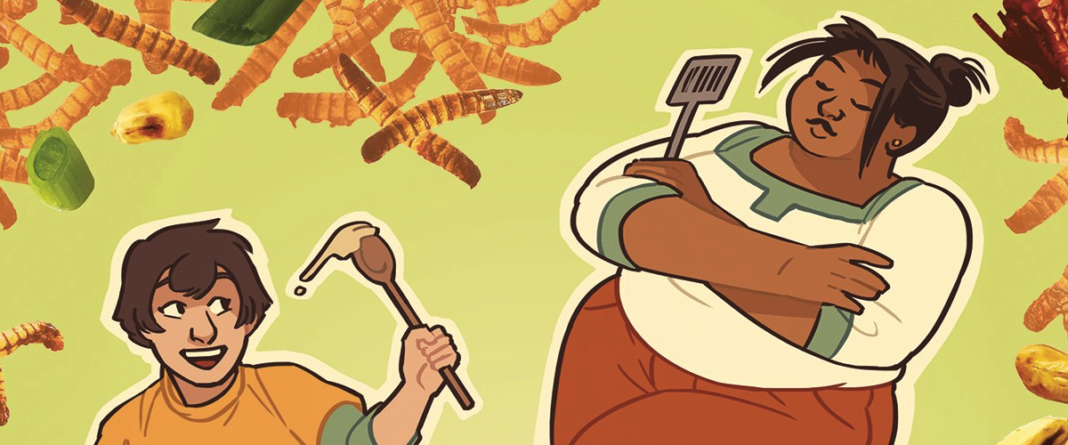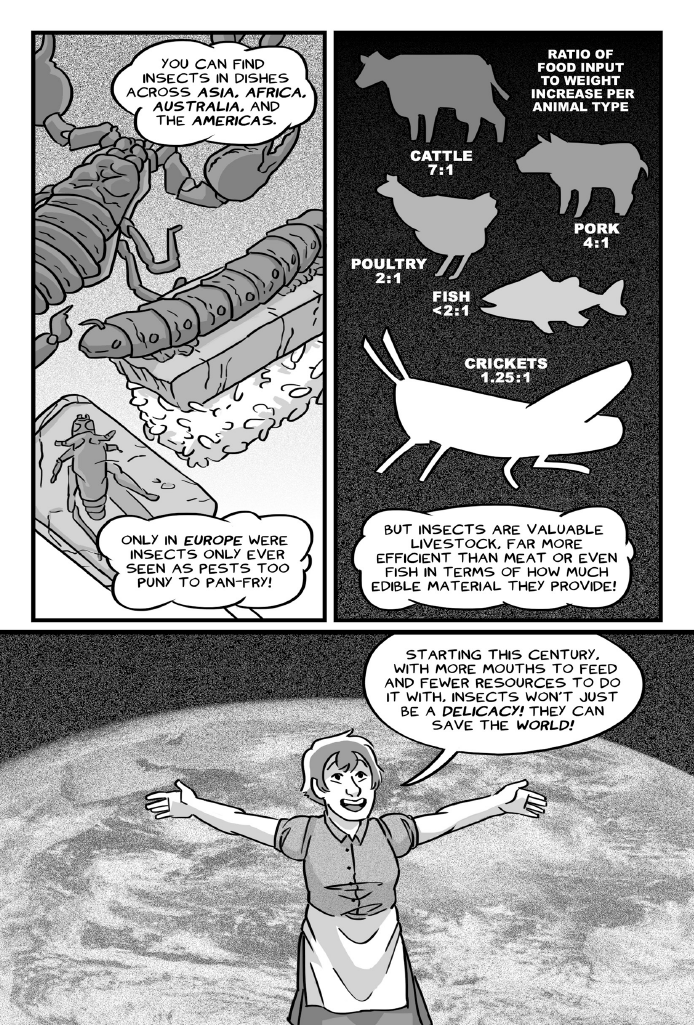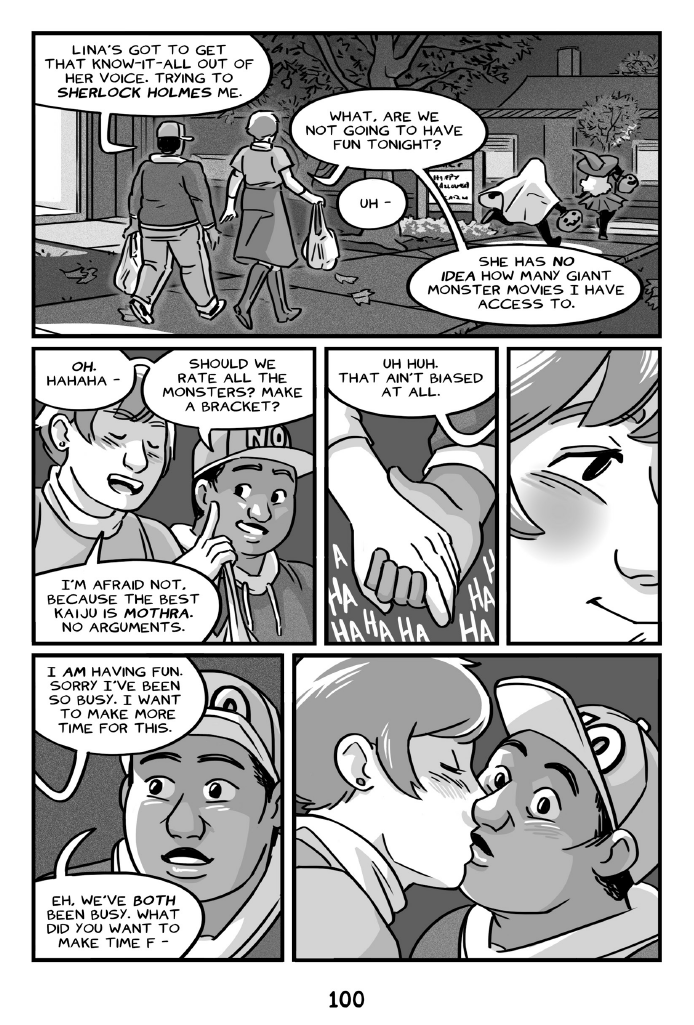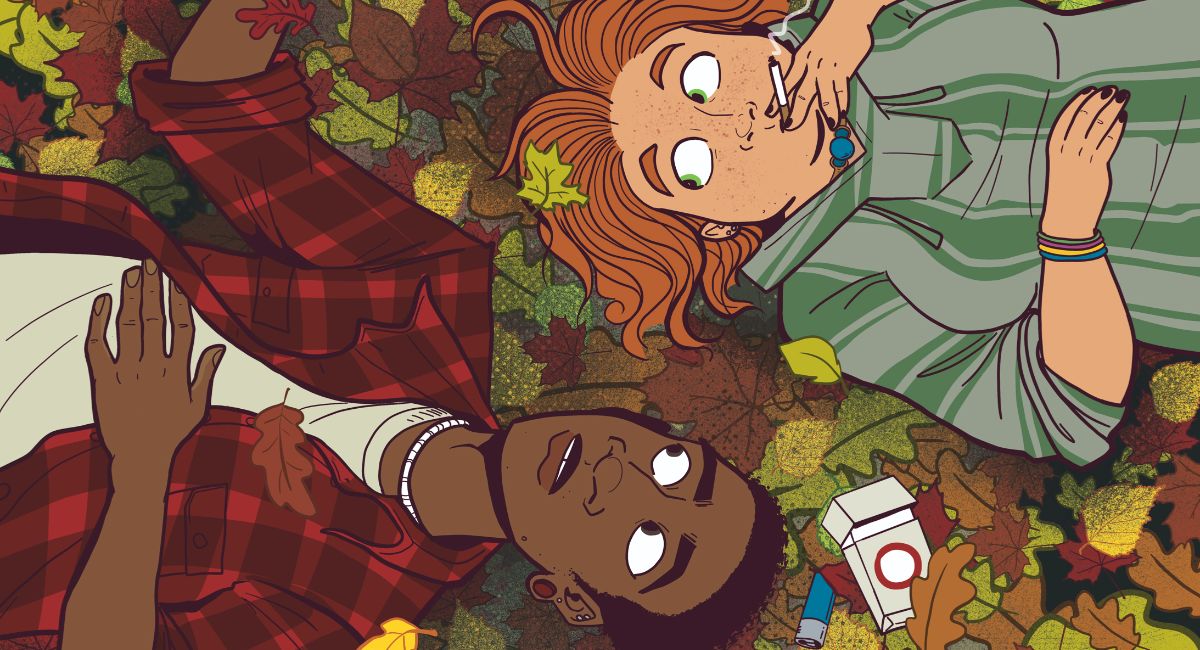Welcome to Queerness in Comics, a bi-weekly column by Avery Kaplan that will explore queer representation in comics. This week, Avery is exploring Meal, a graphic novel published in October 2018. Meal is a Junior Library Guild Selection, the winner of a 2018 VLA Graphic Novel Diversity Award, and the winner of a Prism Award in 2019.
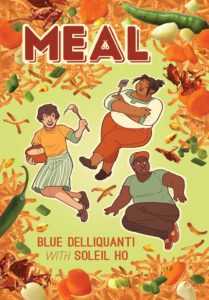
Co-Writer: Soleil Ho
Publisher: Iron Circus Comics
The idea of eating insects will not be entirely unprecedented for some readers of the graphic novel Meal, a fact specifically addressed by the essay that appears at the end of the story. Like co-writer Soleil Ho (who was appointed food critic for the San Francisco Chronicle shortly after Meal’s release), a portion of the audience is likely to have first knowingly experienced the idea of insects-as-food through the lollipops containing insects that are sold in museum gift shops.
However, as demonstrated by the narrative that proceeds the essay, categorizing insect cuisine as a curiosity to be sold to schoolchildren on museum field trips is not only a disservice to entomaphagy. It’s a method of erasing the deeper meaning and function possessed by insect cuisine for many cultures around the world. While the narrative of Meal confronts and illuminates this reality, the story’s warm and welcoming tone does so without alienating the reader, no matter what degree of experience with eating insects they may possess.
Yarrow and Milani
In order to ensure that readers who have not considered insects to be food are able to access the narrative, the opening pages are presented from Milani’s perspective. While Yarrow has traveled from California to Minnesota in the hopes of landing a job in the kitchen of La Casa Chictana, a soon-to-be-open restaurant serving insect cuisine, Milani is startled to open Yarrow’s refrigerator and find a container filled with mealworms.
While Milani is initially surprised by the contents of Yarrow’s fridge, she and Yarrow have already begun to develop trust for one another. As such, Milani is willing to try the mealworm curry Yarrow prepares for her. By allowing the reader to use Milani’s perspective as a surrogate, the story allows the reader to both be taken in by Yarrow’s passionate explanation of the meal, as well as to overcome any initial trepidation they might have concerning the use of insects as protein in a food dish.
Conveying Flavor Through Panels
One of the myriad ways that Meal succeeds is through its incredible visual presentation of flavor. When a character takes a bite of one of the prepared dishes, panels appear that not only express the flavor of the food but the sensation of eating it. In some instances, this means connecting the taste with other familiar sensory experiences, such as music or weather. In other instances, biting into a certain dish leads to panels that flashback to a particular character’s past experiences with the food.
These flashbacks frequently involve experiences that the characters shared with family members during childhood. In a crucial scene, Yarrow manages to win over the skeptical head chef and owner of La Casa Chictana, Chandra Flores.
When she first introduces herself at La Casa Chictana, Chandra is concerned that Yarrow is only interested in insect cuisine in a reactionary sense. Chandra is frustrated with Yarrow’s analysis of the food as an “adventure” for diners and her lamentation of the fact that the restaurant won’t be open in time for Halloween, which would afford the chance to present selections “bug treats” for people (calling to mind the museum lollipops mentioned by the essay).
In order to overcome Chandra’s initial skepticism, Yarrow is charged with creating a serviceable taco for the restaurant’s menu. After an adventure in gathering the ingredients (which includes some fascinating insight into the process of acquiring insects, as well as the personal connection one of the other employees has with the food), Yarrow brings her culinary creation to be sampled by Chandra.
Chandra’s first bite of the taco leads to a flashback to Yarrow’s childhood and the memory of her grandmother taking her to forage in the park for grasshoppers. While the answers Yarrow gave Chandra about why she wanted to share insect cuisine weren’t untrue, they did not reach the heart of the reason Yarrow wants to share these meals: she wants to cook in order to share her memories.
La Casa Chictana
The tacos succeed in winning over Chandra, who invites Yarrow to come to her home in order to help her further develop the menu for the soon-to-be-open restaurant. There, Yarrow samples some fried tarantulas, which leads to a flashback to Chandra’s childhood that reveals the connection between the cuisine and her mother, a Cambodian refugee who was forced to flee her country and move to California in 1979.
Not only does Chandra share the meal with Yarrow, she also shares her personal history with the cuisine, as well as the connection it has with music – as they eat, they listen to the songs of Sinn Sisamouth, a 1960s Cambodian musician who was among those who vanished with the rise of the Khmer Rouge.
Chandra explains that entomophagy allowed her to build a community that she was otherwise lacking, and that to reduce the foundation of that community to a culinary curiosity was a disservice to the very meaningful connections it allowed her to form, both with her family and with others who shared similar experience and interests.
Forging Connections Through Food
Meal goes deeper the idea of eating one specific type of food (in this case, insects) in order to deconstruct the role that food plays when we build connections. What does it mean to share a meal over a dinner table, or when we prepare food to nourish our families, friends, and those closest to us?
The way that food can help bring people together is foregrounded in the budding romantic relationship between Yarrow and Milani. While Milani is initially concerned that a kiss shared between the two is too much of a commitment, the foundation connection between the two, which was strengthened through the sharing of meals, proves tenacious enough to endure the reticence.
Meal demonstrates that food is a multifaceted and meaningful avenue for forging connections and community by showing how a queer relationship is formed and strengthened over shared meals.


